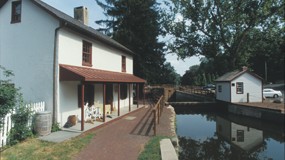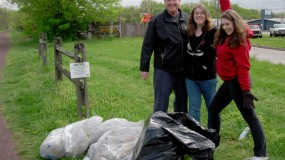“Something has to be done!”
AND THE PEOPLE WHO MADE IT HAPPEN
Since the formation of the Delaware Canal State Park (originally called Roosevelt State Park) in 1940, residents along the 58.9-mile greenway have advocated for the restoration and preservation of this vital community asset. Many canals throughout the country have been filled in and paved over. The Delaware Canal remains one of the last canals capable of being fully watered once again. Many notable people have made significant contributions to the Canal over the years. And, while we can’t mention them all, we can honor those that left a unique legacy for future generations.
Betty Orlemann—A Force for Nature
“Something has to be done” indeed. This short but telling quote from the founder of the Friends of the Delaware Canal, Betty Orlemann, set the tone for the vision and purpose of this organization.
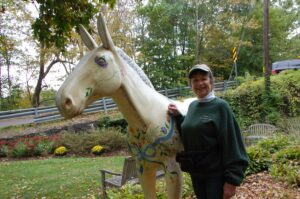
In 1977, Betty and her young family took up residence in an old farmhouse on River Road in Smithtown adjacent to the Delaware Canal. Seeing the disrepair and neglect of the Canal, bridges, and towpath, she organized volunteers to get to work, doing what they could to improve the Canal and its surroundings.
This small early band of volunteers was the start of what Betty would call the Friends of the Delaware Canal. The Friends had their first official meeting in October 1982, and by January 1983, they were incorporated. One of the first members of this newly formed non-profit was Virginia Forrest.
Betty was also a founder and Board member of the Delaware & Lehigh National Heritage Corridor (D & L) and the creative inspiration behind the Miles of Mules art installation. In 2009, Betty was presented with the first Lifetime Achievement Award from the D & L National Heritage Corridor.
Virginia Forrest—Crusading Conservationist
Virginia O. Ranson Forrest was a lifelong conservationist. In the 1970s, as a member of the Delaware Valley Protective Association (DVPA), a precursor to the Friends, Virginia, along with Will Rivinus, Hal Clark, and C.P. Yoder, were instrumental in attaining the designation of National Historic Landmark for the Delaware Canal. This recognition helps preserve and protect the Canal and towpath today.
Virginia passed away in 1991; however, her legacy lives on. A popular recreation area along the Canal in New Hope bears her name, and she was the catalyst behind several other important conservation-minded groups.
Ms. Forrest founded the Bucks County Conservation Alliance and the Bucks County Audubon Society. And at the age of 83, she received the Conservation Service Award, the highest honor given to a citizen by the U.S. Department of the Interior.
Zabel Davis—Making It Happen
Zabel Davis, Friends’ fundraiser extraordinaire, never ran from a challenge. So, when the Friends and the Park determined that the Canal needed some major excavation work, Zabel marshaled efforts to raise money for a dredging machine.
This equipment had a price tag of $100,000, a figure that would scare most from pursuing this acquisition. But undaunted, Zabel made up her mind and began raising funds by any means possible.
Through her efforts, and those of Friends members, the Pledge for the Dredge was a success. It took three years and numerous fundraising activities including cookbook sales, barge parties, and teas. Pennsylvania gratefully accepted the donation, the largest amount raised by an organization for a state project.
Susan Taylor—A Legacy of Service
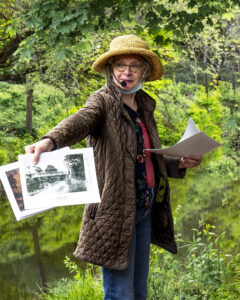
Susan began her relationship with the Friends as a volunteer, helping wherever she could to support their efforts. Her enthusiasm and commitment led the Friends to offer Susan the position of Executive Director of the organization, a position she held for 30 years. Now retired, Susan’s legacy continues to inspire us all.
During Susan’s tenure, much was accomplished. Camelback bridges were rebuilt, interpretive signs were installed, and the Locktender’s House was restored. Susan also created the Loop Trails, a popular way to travel and explore both sides of the Delaware River and two Canals.
“Since 1991, Susan Taylor has served as the Executive Director of the non-profit Friends of the Delaware Canal,” said Representative Brian Fitzpatrick during Susan’s retirement celebration. “For over 30 years, Susan helped preserve and protect this Canal, which helps link our community to our shared history and our area’s natural beauty…let us honor her legacy of dedicated service to this historic treasure.”
Will Rivinus—Historian, Author, and Devoted Canal Promoter
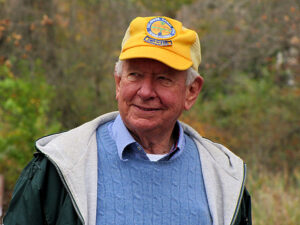
Much of the interest in the historical and ecological importance of the Delaware Canal can be attributed to the lifelong dedication of Will Rivinus. “I went on up the towpath to Easton, and I said this area is phenomenal. It has a slice of the Atlantic coast of America” said Rivinus in a recent interview. “You really need a book about the Delaware Canal. It’s fascinating.” And so, Will did just that, he wrote a book.
The Wayfarer Guide to the Delaware Canal was first published in 1964. In all, Will wrote and published eight editions of the book which included photographs from Louis Comfort Tiffany, who liked to take canal excursions on his boat, the Molly-Polly Chucker.
Will’s enthusiasm didn’t stop at writing about the Canal. In 1987, he led the first Canal Walk, a tradition that continues today. His tireless advocacy has been recognized by both the Senate and the House of Representatives of Pennsylvania.
Dennis Gerhart—Illustrator Extraordinaire
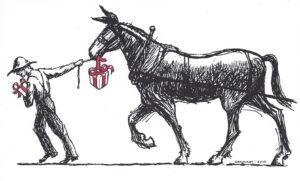
No one could draw a mule like Dennis Gerhart. And he shared his love of these creatures and the Canal through his numerous illustrations, children’s books and field trip classes.
Dennis was an industrial designer by training. But it was his talent for interpreting historic structures and scenes that enhanced our understanding of the inner workings of the Canal. Dennis Scholl, an author and Education Manager at the Delaware & Lehigh Heritage Corridor said Dennis “was a unique person who not only was a master illustrator but also a man who truly understood history and could interpret it accurately, with great precision through his art. His art reflected that. He drew the best mules I have ever seen.”
Dennis may be gone from us too soon, but he left behind an archive of material that will continue to educate, inform, and amuse future generations.
Pete Sperry—Creator of Landmark and Mileage Chart
When Pete Sperry participated in his first Canal Walk, sponsored annually by the Friends of the Delaware Canal, he was full of “where” questions. There were no reliable mile markers or any accurate way of knowing where you were and how far you had traveled.
So, in 2002, Pete began the challenging task of documenting and setting distances along the towpath trail. His approach was two-pronged. The mile marker situation had to be corrected, and a detailed chart of mileage and landmarks needed to be developed.
Today, his Landmarks and Mileage Chart has proven to be an invaluable resource for visitors, educators, and park staff. The information on the chart is color-coded to highlight key structures and features along the way. And it includes latitude/longitude coordinates that visitors can use to plot their course with a mapping program (like Google Maps).
You can find the Landmark and Mileage chart on our website.
William Taylor—Artist and Early Friend
Before the Friends of the Delaware Canal came into being, there was the Delaware Valley Protective Association, and William Taylor was its first president. Formed in 1933, the DVPA was responsible for encouraging the state to restore and maintain the Canal. Later, the organization was also responsible for securing an essential historic national landmark designation, protecting the Canal and towpath for generations to come.
In 1939, Taylor launched a magazine titled Towpath Magazine, a monthly publication dedicated to preserving “the beauty and value of the valley.” He wrote numerous articles focused on nature and the environment.
As an artist, William Taylor was considered part of the New Hope Impressionist School. He was well known for his landscapes and a depiction of Washington crossing
the Delaware. His works can be found at the Corcoran Gallery and the Metropolitan Museum of Art.
Other notable Canal Supporters
While many people have been a positive influence on the Canal, here are a few whose contributions made a lasting impact on the Friends as well.
Dave Heckler, a former State legislator, was instrumental in encouraging the state to buy the Locktender’s House and lease it to the Friends. The Friends, in turn, restored the house and maintain it as their headquarters and canal museum.
Robert F. Pierson was the founder of the Heritage Foundation and an early Friends supporter. He developed a database of Canal neighbors, a vital mailing list used to drive interest and membership.
C.P. Yoder, author of Delaware Canal Journal and a founding member of the Delaware Valley Protective Association. Yoder, along with Will Rivinus, Virginia Forrest and Hal Clark, lobbied for and secured the National Historic Landmark designation for the Canal and towpath.
Canal Tenders and Volunteers
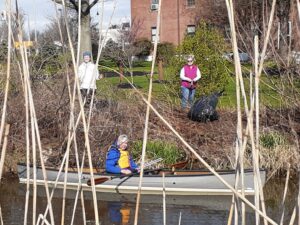
From Bristol to Easton, residents understand the value of the Canal and towpath which connects communities with each other and with nature.
However, our Canal Tenders are at the heart of maintaining the towpath for all to enjoy. Each one has a designated section of the path they maintain, keeping it clean and visitor friendly. They often go above and beyond, removing large amounts of trash and debris and alerting the Friends and park staff of critical issues.
Every year, we welcome a new season with a Canal Clean-up Day. One hundred plus volunteers descend on the towpath with bags, gloves, and tools in hand to clear the way for the arrival of spring.
The Canal Tenders, seasonal volunteers, and financial supporters of the Friends all work to preserve and protect this important landmark. They carry on the legacy of so many others who came before us and set an example for future generations to follow.
WE BAGGED IT!
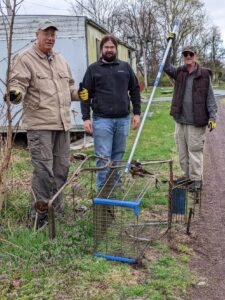
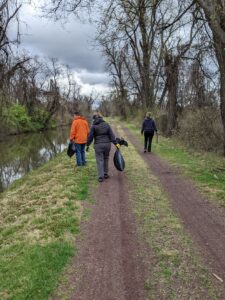
Canal Clean-up day 2022 was a BIG success, and reports from our Canal Clean-up Volunteers are in…
“The morning was a lot of fun, and it was nice meeting some new people. And, we had a few walkers thank us, which really makes it all the more worthwhile! It was a very successful Canal Clean-up Day!” —Barb Dalglish
“Well that was fun! This group worked well together, and oddly, three of our four volunteers are users of the canal, but none were from our immediate area. It was a very productive morning, mild weather, everyone happy to be able to contribute.” —Charlie Bozzo.
After two years of COVID protocols, we were finally able to gather in teams to clean-up the canal and towpath. And while flooding may have postponed the clean-up in the northern sections of the towpath, in the south, it was all-hands-on-deck and paddles in the water on April 9. Most of the northern clean-ups took place during the following weeks.
Over the course of our clean-up activities, more than one hundred volunteers divided and conquered some of the most troublesome spots on the towpath. In less than 4 hours, the teams gathered 90 bags of trash (give or take) along with a shopping cart, a swimming pool, and lots of debris. Along the way, our volunteers took pictures of problem areas, hazards, and dump sites. We provided this vital input to the park staff for further investigation and resolution. When we work together, we can accomplish a great deal. And, cooperation was certainly evident during this annual clean-up. Volunteers assisted where they were needed most and got to know another section of the canal along with its neighbors.
From the comments we received, all participants were happy to participate and make a difference. So, until next year, see you on a cleaner, more welcoming towpath!
SOMMER’S BRIDGE RESTORATION:
THE FAMILY LEGACY LIVES ON
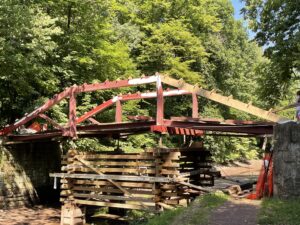
The Sommer’s Bridge Restoration, which started in May, became a more complicated project. Additional timbers were identified as needing replacement, increasing the time and materials needed to complete the job. Most of the initial required funding was donated by the Sommer’s Family, along with contributions from other generous donors. Donations and additional funding will be needed to finance the completed project.
Anatomy of a Canal
Construction of the Delaware Division of the Pennsylvania Canal system began in 1827 and was completed by 1832. The quick work created a less than water-worthy structure and the canal quickly required additional funding and manpower to keep the boats afloat.
However leaky the original design, it included many features and mechanisms that can still be seen today. In fact, some are still in use.
From Bristol, the Delaware Canal rises 165 feet above sea level in Easton. This elevation change was overcome using 23 lift locks. Other structures Other structures along the canal included: 10 aqueducts, 21 waste gates, 8 stop gates, 27 overflows, 125 bridges, 1 weigh lock at Easton, 1 outlet lock and 1 tide lock. With careful restoration, preservation and maintenance locks, waste gates, and bridges add to the historic value of this natural resource.
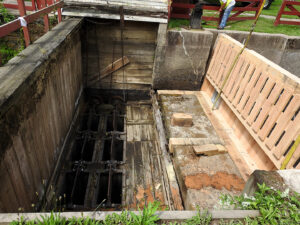
The canal structure itself is called the prism. Its name comes from the shape, being narrower on the bottom and wider on top, creating a “prism.” The bed of the canal was generally lined with clay, but in the haste of construction, other more porous materials were put to use.
Waste gates and stop gates may sound similar but they serve two different functions. Waste gates are used to lower the water level in the canal (eliminating extra or “waste” water). Stop gates are used to divert water back into the river, protecting the canal downstream from flooding. During times of torrential rains, these gates are vital to preserving not only the canal structure but neighboring property as well.
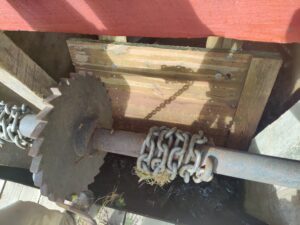
Overflows or spillways are also used to control the level of the canal. During the recent rainstorms and Ida, these spillways became so inundated with water, that pedestrians could not pass for fear of being swept away. On a normal day, bikers, hikers and walkers alike may get a bit wet but they can easily cross these concreate structures.
By far, the most complex mechanism along the canal is the lift lock. Locks are essentially elevators for canal boats. These enclosures were either filled with water or emptied, depending on whether the canal boat was traveling upstream (higher elevation) or downstream (lower elevation.) The lock chamber consisted of a floor, two walls and lock gates at either end. It was filled or emptied using openings in the lock gates, called wickets. (cont’d next page)
Steps to locking in when going downstream:
1. If the lock is empty, the lower miter gates are closed. The lock is then filled with water by opening the wickets (rotating valves) in the bottom section of the upper gates.
2. When the lock is full, the upper miter gates are opened, and the canal boat enters.
3. The wickets in the upper gates are shut, and the upper miter gates are fully closed.
4. The wickets in the lower gate are opened, and the level of the water in the lock is dropped until it is the same as the water level below the lock, lowering the boat.
5. When the water levels match, the lower miter gates are opened and the canal boat is pulled out of the lock and continues on its southward journey.
Lift locks have been in use for centuries in China as well as the Netherlands and Belgium. Variations of the standard lock can be found in the Theodore Roosevelt Recreation area, where two locks, Locks 22 and 23, were combined into one. At the beginning of the canal in the north, is a Weigh Lock in Easton. At the southernmost point along the canal is a Tidal Lock in Bristol.
Aqueducts are another important feature of the Delaware Canal. There are 10 aqueducts along the length of the waterway. Recent storm damage caused two of these structures to weaken or collapse entirely. Replacements and repairs are being planned for the aqueducts in Point Pleasant and Lumberville. When still in use as a transportation corridor, the aqueducts on the canal transversed streams carrying not only water but the boats as well. In later years, when commercial use stopped, these structures became a favorite watering hole of local bathers.
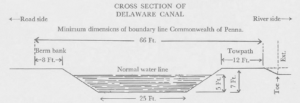
PARK MANAGER’S REPORT by Brian Heath
ith spring having sprung, and summer’s heat on the horizon, our staff and equipment have yet again taken afield to continue our annual duties of conducting maintenance and upkeep, and providing public safety and education, within our beloved park. The myriad of challenges associated in operating a park of this size and complexity continue, but we work diligently to meet our goals and fulfill our mission with continued support from the communities we serve.
Staffing: Currently the park has several seasonal maintenance vacancies and other opportunities may exist. Interested persons should contact our park office at 610-982-5560.
Aquatic Invasive Management: The park has been awarded a grant from NOAA to complete field surveys identifying target species and management areas with special consideration for habitat value, operational integrity, and recreational use of the canal.
New Equipment: Purchase orders for new mowing equipment will supplement our current operations. In the meantime, staff has begun normal seasonal mowing operations, and is working through delays due to equipment down time. We appreciate your patience and look forward to the new deliveries.
Water: In the north, staff has sent water as far south as possible, to approximately Kintnersville, before the impasse at High Falls Creek. In the south, our staff has been working diligently to keep the canal at a consistent water level. Staff and management rely on weather forecasts to gauge how much water should be flowing out of the canal at a given time, and weather patterns this spring have proven to be a challenge.
Sommer’s Bridge: Work at Sommer’s Bridge is moving forward, thanks to generous support from the Friends of the Delaware Canal! One of the few remaining authentic camelback truss bridges, a maintenance condition discovered at Sommer’s in January forced its closure.
There are many other projects that are in some phase of construction. Some are out to bid, others are awaiting final design approvals. Some projects will be completed by the park staff.
Other projects include:
• MP 53-59 Berm & Trail Flood Repairs
• Sunday Road Bridge Replacement
• Highfalls Creek Sub-Canal Culvert Replacement
• Spahr’s Authentic Camelback Truss Bridge
• Tohickon Aqueduct Repair
• Lumbersville Aqueduct over Paunacussing Creek
Thank you all for your continued support. See you on the towpath!
